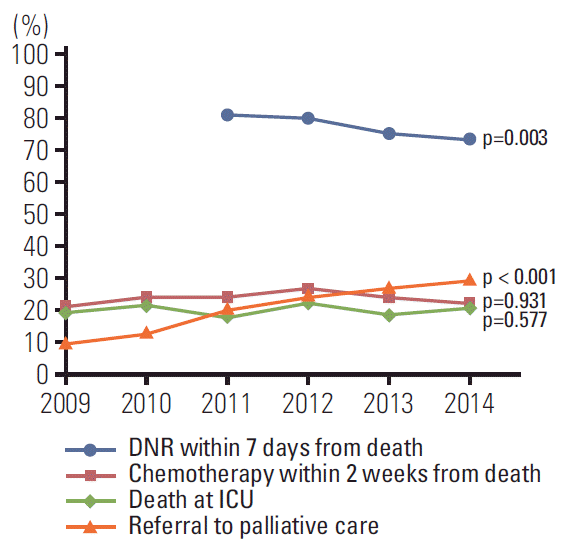1. Economist Intelligence Unit. The 2015 Quality of Death Index: ranking palliative care across the world. Singapore: Lien Foundation;2015.
2. Woitha K, Carrasco JM, Clark D, Lynch T, Garralda E, MartinMoreno JM, et al. Policy on palliative care in the WHO European region: an overview of progress since the Council of Europe's (2003) recommendation 24. Eur J Public Health. 2016; 26:230–5.

3. Earle CC, Landrum MB, Souza JM, Neville BA, Weeks JC, Ayanian JZ. Aggressiveness of cancer care near the end of life: is it a quality-of-care issue? J Clin Oncol. 2008; 26:3860–6.

4. Ho TH, Barbera L, Saskin R, Lu H, Neville BA, Earle CC. Trends in the aggressiveness of end of life cancer care in the universal health care system of Ontario, Canada. J Clin Oncol. 2011; 29:1587–91.
5. Jang RW, Krzyzanowska MK, Zimmermann C, Taback N, Alibhai SM. Palliative care and the aggressiveness of end-of-life care in patients with advanced pancreatic cancer. J Natl Cancer Inst. 2015; 107:dju424.

6. Taberner Bonastre P, Taberner Bonastre MT, Soler Company E, Perez-Serrano Lainosa MD. Chemotherapy near the end of life; assessment of the clinical practise in onco-hematological in adult patients. Farm Hosp. 2016; 40:14–24.
7. Chang TS, Su YC, Lee CC. Determinants for aggressive end-of-life care for oral cancer patients: a population-based study in an Asian country. Medicine (Baltimore). 2015; 94:e460.
8. Temel JS, Greer JA, Muzikansky A, Gallagher ER, Admane S, Jackson VA, et al. Early palliative care for patients with metastatic non-small-cell lung cancer. N Engl J Med. 2010; 363:733–42.

9. Wright AA, Zhang B, Ray A, Mack JW, Trice E, Balboni T, et al. Associations between end-of-life discussions, patient mental health, medical care near death, and caregiver bereavement adjustment. JAMA. 2008; 300:1665–73.

10. Balaban RB. A physician's guide to talking about end-of-life care. J Gen Intern Med. 2000; 15:195–200.

11. Smith TJ, Temin S, Alesi ER, Abernethy AP, Balboni TA, Basch EM, et al. American Society of Clinical Oncology provisional clinical opinion: the integration of palliative care into standard oncology care. J Clin Oncol. 2012; 30:880–7.

12. Teno JM, Shu JE, Casarett D, Spence C, Rhodes R, Connor S. Timing of referral to hospice and quality of care: length of stay and bereaved family members' perceptions of the timing of hospice referral. J Pain Symptom Manage. 2007; 34:120–5.

13. Morita T, Akechi T, Ikenaga M, Kizawa Y, Kohara H, Mukaiyama T, et al. Late referrals to specialized palliative care service in Japan. J Clin Oncol. 2005; 23:2637–44.

14. Hospice and Palliative Care. Hospice and palliative care in Korea: facts and figures 2017. Goyang: Hospice and Palliative Care;2019.
15. Hospice and Palliative Care [Internet]. Goyang: Hospice and Palliative Care;2019. [cited 2019 Jul 3]. Available from:
http://hospice.cancer.go.kr.
16. Yun YH, Kwak M, Park SM, Kim S, Choi JS, Lim HY, et al. Chemotherapy use and associated factors among cancer patients near the end of life. Oncology. 2007; 72:164–71.

17. Oh DY, Kim JH, Kim DW, Im SA, Kim TY, Heo DS, et al. CPR or DNR?: end-of-life decision in Korean cancer patients: a single center's experience. Support Care Cancer. 2006; 14:103–8.

18. Kim DY, Lee KE, Nam EM, Lee HR, Lee KW, Kim JH, et al. Do-not-resuscitate orders for terminal patients with cancer in teaching hospitals of Korea. J Palliat Med. 2007; 10:1153–8.

19. Baek YJ, Shin DW, Choi JY, Kang J, Mo HN, Kim YH, et al. Late referral to palliative care services in Korea. J Pain Symptom Manage. 2011; 41:692–9.
20. Choi Y, Keam B, Kim TM, Lee SH, Kim DW, Heo DS. Cancer treatment near the end-of-life becomes more aggressive: changes in trend during 10 years at a single institute. Cancer Res Treat. 2015; 47:555–63.

21. Yoo SH, Keam B, Kim M, Kim TM, Kim DW, Heo DS. The effect of hospice consultation on aggressive treatment of lung cancer. Cancer Res Treat. 2018; 50:720–8.

22. Park SJ, Nam EJ, Chang YJ, Lee YJ, Jho HJ. Factors related with utilizing hospice palliative care unit among terminal cancer patients in Korea between 2010 and 2014: a single institution study. J Korean Med Sci. 2018; 33:e263.

23. Amano K, Morita T, Tatara R, Katayama H, Uno T, Takagi I. Association between early palliative care referrals, inpatient hospice utilization, and aggressiveness of care at the end of life. J Palliat Med. 2015; 18:270–3.

24. Maltoni M, Scarpi E, Dall'Agata M, Schiavon S, Biasini C, Codeca C, et al. Systematic versus on-demand early palliative care: a randomised clinical trial assessing quality of care and treatment aggressiveness near the end of life. Eur J Cancer. 2016; 69:110–8.

25. Lee HS, Chun KH, Moon D, Yeon HK, Lee S, Lee S. Trends in receiving chemotherapy for advanced cancer patients at the end of life. BMC Palliat Care. 2015; 14:4.

26. Lee SW, Jho HJ, Baek JY, Shim EK, Kim HM, Ku JY, et al. Outpatient palliative care and aggressiveness of end-of-life care in patients with metastatic colorectal cancer. Am J Hosp Palliat Care. 2018; 35:166–72.

27. Hui D, Didwaniya N, Vidal M, Shin SH, Chisholm G, Roquemore J, et al. Quality of end-of-life care in patients with hematologic malignancies: a retrospective cohort study. Cancer. 2014; 120:1572–8.

28. Howell DA, Shellens R, Roman E, Garry AC, Patmore R, Howard MR. Haematological malignancy: are patients appropriately referred for specialist palliative and hospice care?: a systematic review and meta-analysis of published data. Palliat Med. 2011; 25:630–41.





 PDF
PDF Citation
Citation Print
Print



 XML Download
XML Download